Analytical Investigation of a Novel System for Combined Dew Point Cooling and Water Recovery
Abstract
Featured Application
Abstract
1. Introduction
2. Materials and Methods
2.1. Operational Principles of the DPC-WR System
2.2. Mathematical Model of the DPC-WR System
- Steady-state operation;
- Airflow is modeled as an ideal gas;
- Properties of water and air streams are equal to bulk averaged values;
- Thermal conductivity along channel length through plate and water is negligible;
- Heat losses to the surroundings are neglected;
- Mass transfer of water vapor is driven by partial pressure gradient.
2.2.1. Mathematical Model of the First Stage of the DPC-WR System
2.2.2. Mathematical Model of the Second Stage of the DPC-WR System
2.2.3. Initial Conditions for the Mathematical Model of the DPC-WR System
2.3. Validation of the Mathematical Model
3. Results
3.1. Performance Indicators
3.2. Performance of the DPC-WR System under Different Climatic Conditions
4. Discussion
5. Conclusions
6. Patents
Author Contributions
Funding
Institutional Review Board Statement
Informed Consent Statement
Data Availability Statement
Conflicts of Interest
Nomenclature
| cp | kJ/(kg·K) | moist air specific heat capacity |
| Rh | m | hydraulic radius |
| f | - | coefficient of fluid friction |
| G | kg/s | mass flow rate |
| L | m | channel length |
| Le | - | Lewis factor |
| M | kg/s | mass transfer rate of water vapor |
| Nnet | kWh | electric energy input |
| NTU | - | number of transfer units |
| Δp | Pa | pressure drop |
| kW | heat transfer rate | |
| Re | - | Reynolds number |
| t | °C | temperature |
| u | m/s | mean velocity |
| m3/s | volume flow rate of air | |
| kW | electric power input | |
| x | kg/kg | moist air humidity ratio |
| X | m | coordinate along the product airflow direction |
| - | relative X coordinate | |
| Y | m | coordinate perpendicular to the primary airflow direction |
| η | - | fan efficiency |
| ν | m2/s | kinematic viscosity |
| ρa | kg/m3 | density of air |
| Subscripts: | ||
| ′ | related to the air–plate or air/water interface | |
| ″ | related to the plate surface | |
| 1 | related to the primary channels in the 1st stage of the DPC-WR system | |
| 2 | related to the secondary channels in the 1st stage of the DPC-WR system | |
| 3 | related to the primary channels in the 2nd stage of the DPC-WR system | |
| 4 | related to the secondary channels in the 2nd stage of the DPC-WR system | |
| i | inlet | |
| L | latent heat | |
| o | outlet | |
| p | plate | |
| S | sensible heat | |
| T | total heat | |
| w | water | |
| Y | related to coordinate perpendicular to the primary airflow direction | |
References
- International Energy Agency. Transition to Sustainable Buildings Strategies and Opportunities to 2050; OECD/IEA: Paris, France, 2013. [Google Scholar]
- Greve, P.; Kahil, T.; Mochizuki, J.; Schinko, T.; Satoh, Y.; Burek, P.; Fischer, G.; Tramberend, S.; Burtscher, R.; Langan, S.; et al. Global assessment of water challenges under uncertainty in water scarcity projections. Nat. Sustain. 2018, 1, 486–494. [Google Scholar] [CrossRef]
- International Energy Agency. The Future of Cooling; IEA: Paris, France, 2018. [Google Scholar]
- Wada, Y.; Flörke, M.; Hanasaki, N.; Eisner, S.; Fischer, G.; Tramberend, S.; Satoh, Y.; van Vliet, M.T.H.; Yillia, P.; Ringler, C.; et al. Modeling global water use for the 21st century: The Water Futures and Solutions (WFaS) initiative and its approaches. Geosci. Model Dev. 2016, 9, 175–222. [Google Scholar] [CrossRef]
- Al-Karaghouli, A.; Kazmerski, L.L. Energy consumption and water production cost of conventional and renewable-energy-powered desalination processes. Renew. Sustain. Energy Rev. 2013, 24, 343–356. [Google Scholar] [CrossRef]
- Shahzad, M.W.; Burhan, M.; Ang, L.; Ng, K.C. Energy-water-environment nexus underpinning future desalination sustainability. Desalination 2017, 413, 52–64. [Google Scholar] [CrossRef]
- Heidary, B.; Tavakoli Hashjin, T.; Ghobadian, B.; Roshandel, R. Optimal integration of small scale hybrid solar wind RO-MSF desalination system. Renew. Energy Focus 2018, 27, 120–134. [Google Scholar] [CrossRef]
- Azimibavil, S.; Dehkordi, A.J. Dynamic simulation of a multi-effect distillation (MED) process. Desalination 2016, 392, 91–101. [Google Scholar] [CrossRef]
- Campione, A.; Cipollina, A.; Calise, F.; Tamburini, A.; Galluzzo, M.; Micale, G. Coupling electrodialysis desalination with photo-voltaic and wind energy systems for energy storage: Dynamic simulations and control strategy. Energy Convers. Manag. 2020, 216, 112940. [Google Scholar] [CrossRef]
- Zheng, J.; Yang, M. Experimental investigation on novel desalination system via gas hydrate. Desalination 2020, 478, 114284. [Google Scholar] [CrossRef]
- Skuse, C.; Gallego-Schmid, A.; Azapagic, A.; Gorgojo, P. Can emerging membrane-based desalination technologies replace reverse osmosis? Desalination 2020, 500, 114844. [Google Scholar] [CrossRef]
- Chiranjeevi, C.; Srinivas, T. Combined two stage desalination and cooling plant. Desalination 2014, 345, 56–63. [Google Scholar] [CrossRef]
- Qasem, N.A.A.; Zubair, S.M. Performance evaluation of a novel hybrid humidification-dehumidification (air-heated) system with an adsorption desalination system. Desalination 2019, 461, 37–54. [Google Scholar] [CrossRef]
- Naeimi, A.; Nowee, S.M.; Amiri, H.A.A. Numerical simulation and theoretical investigation of a multi-cycle dual-evaporator adsorption desalination and cooling system. Chem. Eng. Res. Des. 2020, 156, 402–413. [Google Scholar] [CrossRef]
- Anand, B.; Murugavelh, S. Performance analysis of a novel augmented desalination and cooling system using modified vapor compression refrigeration integrated with humidification-dehumidification desalination. J. Clean. Prod. 2020, 255, 120224. [Google Scholar] [CrossRef]
- Xu, P.; Ma, X.; Zhao, X.; Fancey, K. Experimental investigation of a super performance dew point air cooler. Appl. Energy 2017, 203, 761–777. [Google Scholar] [CrossRef]
- Dizaji, H.S.; Hu, E.J.; Chen, L. A comprehensive review of the Maisotsenko-cycle based air conditioning systems. Energy 2018, 156, 725–749. [Google Scholar] [CrossRef]
- Mahmood, M.H.; Sultan, M.; Miyazaki, T.; Koyama, S.; Maisotsenko, V.S. Overview of the Maisotsenko cycle—A way towards dew point evaporative cooling. Renew. Sustain. Energy Rev. 2016, 66, 537–555. [Google Scholar] [CrossRef]
- Chen, Q.; Burhan, M.; Shahzad, M.W.; Ybyraiymkul, D.; Akhtar, F.H.; Ng, K.C. Simultaneous production of cooling and freshwater by an integrated indirect evaporative cooling and humidification-dehumidification desalination cycle. Energy Convers. Manag. 2020, 221, 113169. [Google Scholar] [CrossRef]
- Pandelidis, D.; Cichoń, A.; Pacak, A.; Drąg, P.; Drąg, M.; Worek, W.; Cetin, S. Water desalination through the dew point evaporative system. Energy Convers. Manag. 2021, 229, 113757. [Google Scholar] [CrossRef]
- Anisimov, S.; Pandelidis, D. Numerical study of the Maisotsenko cycle heat and mass exchanger. Int. J. Heat Mass Transf. 2014, 75, 75–96. [Google Scholar] [CrossRef]
- Anisimov, S.; Pandelidis, D. Theoretical study of the basic cycles for indirect evaporative air cooling. Int. J. Heat Mass Transf. 2015, 84, 974–989. [Google Scholar] [CrossRef]
- Chudnovsky, Y.; Kozlov, A. Integrated Industrial Wastewater Reuse via Heat Recovery; PIR-09-004; California Energy Commission: Sacremento, CA, USA, 2014.
- Thirumaleshwar, M. Fundamentals of Heat and Mass Transfer; Pearson India: Chennai, Tamil Nadu, India, 2009. [Google Scholar]
- Peel, M.C.; Finlayson, B.L.; Mcmahon, T.A. Updated world map of the Köppen-Geiger climate classification. Hydrol. Earth Syst. Sci. 2007, 4, 439–473. [Google Scholar]
- American Society of Heating. ASHRAE Handbook-Fundamentals; Refrigerating and Air-conditioning Engineers Inc.: Atlanta, GA, USA, 2013. [Google Scholar]
- Duan, Z.; Zhan, C.; Zhang, X.; Mustafa, M.; Zhao, X.; Alimohammadisagvand, B.; Hasan, A. Indirect evaporative cooling: Past, present and future potentials. Renew. Sustain. Energy Rev. 2012, 16, 6823–6850. [Google Scholar] [CrossRef]
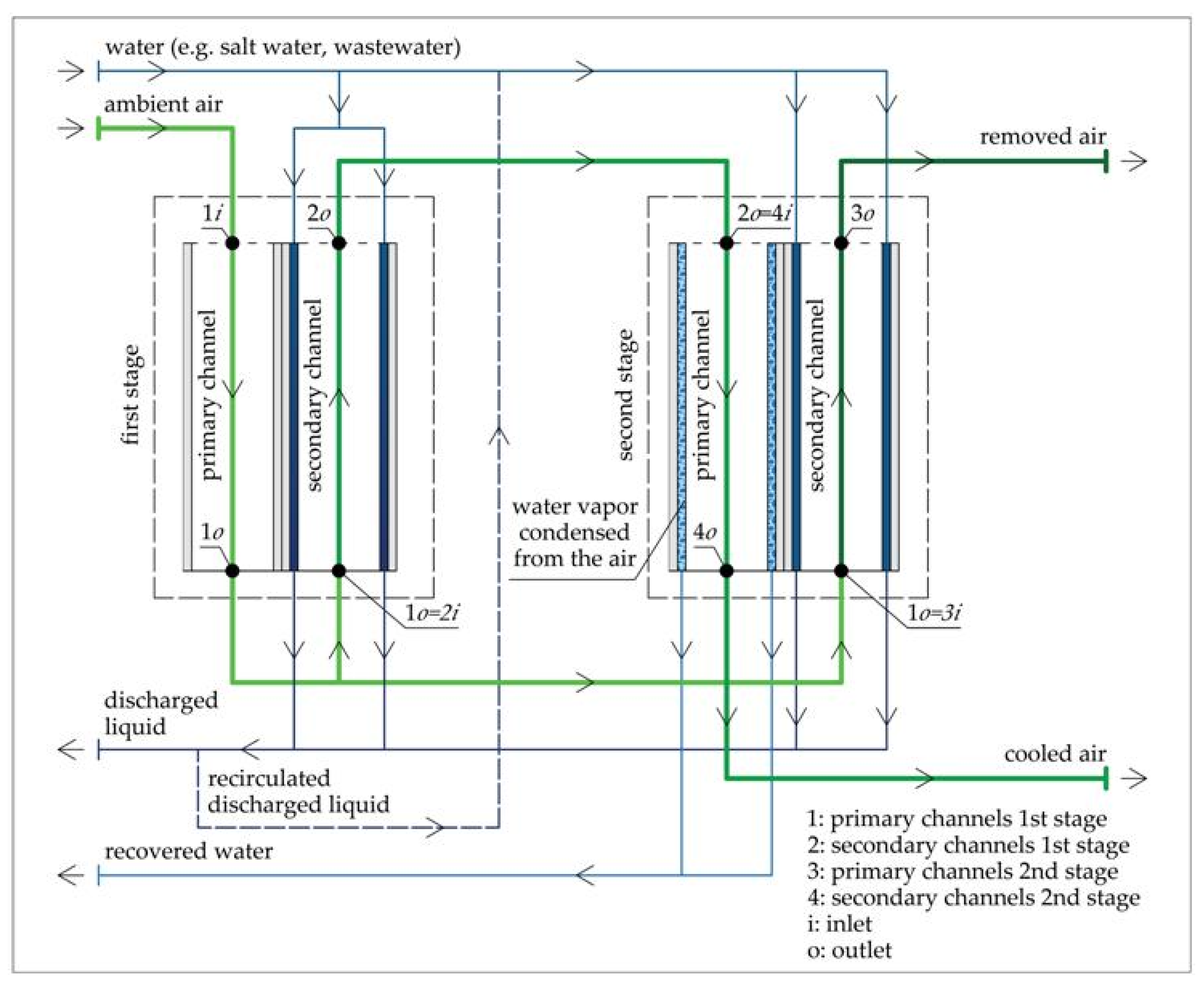
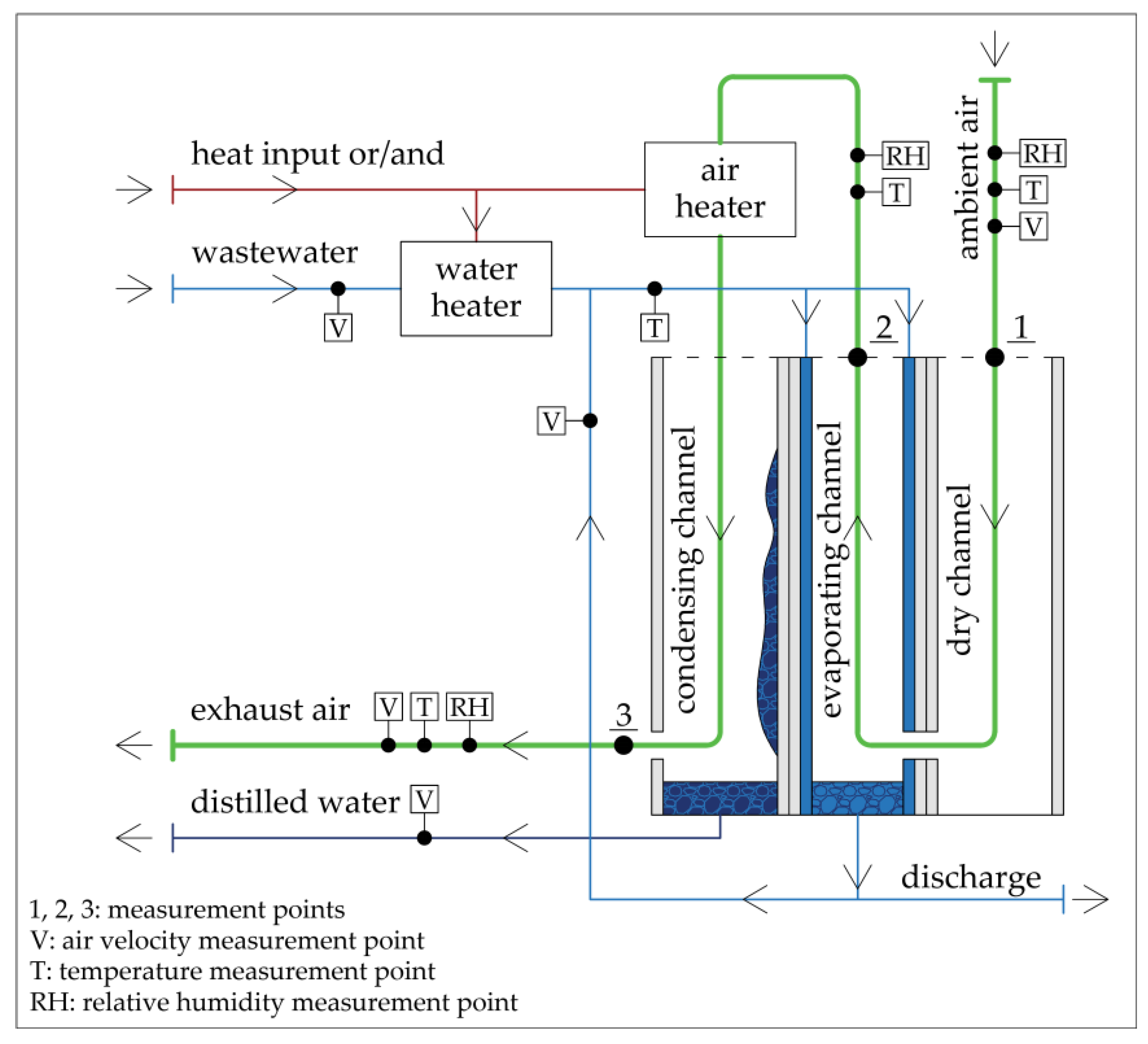
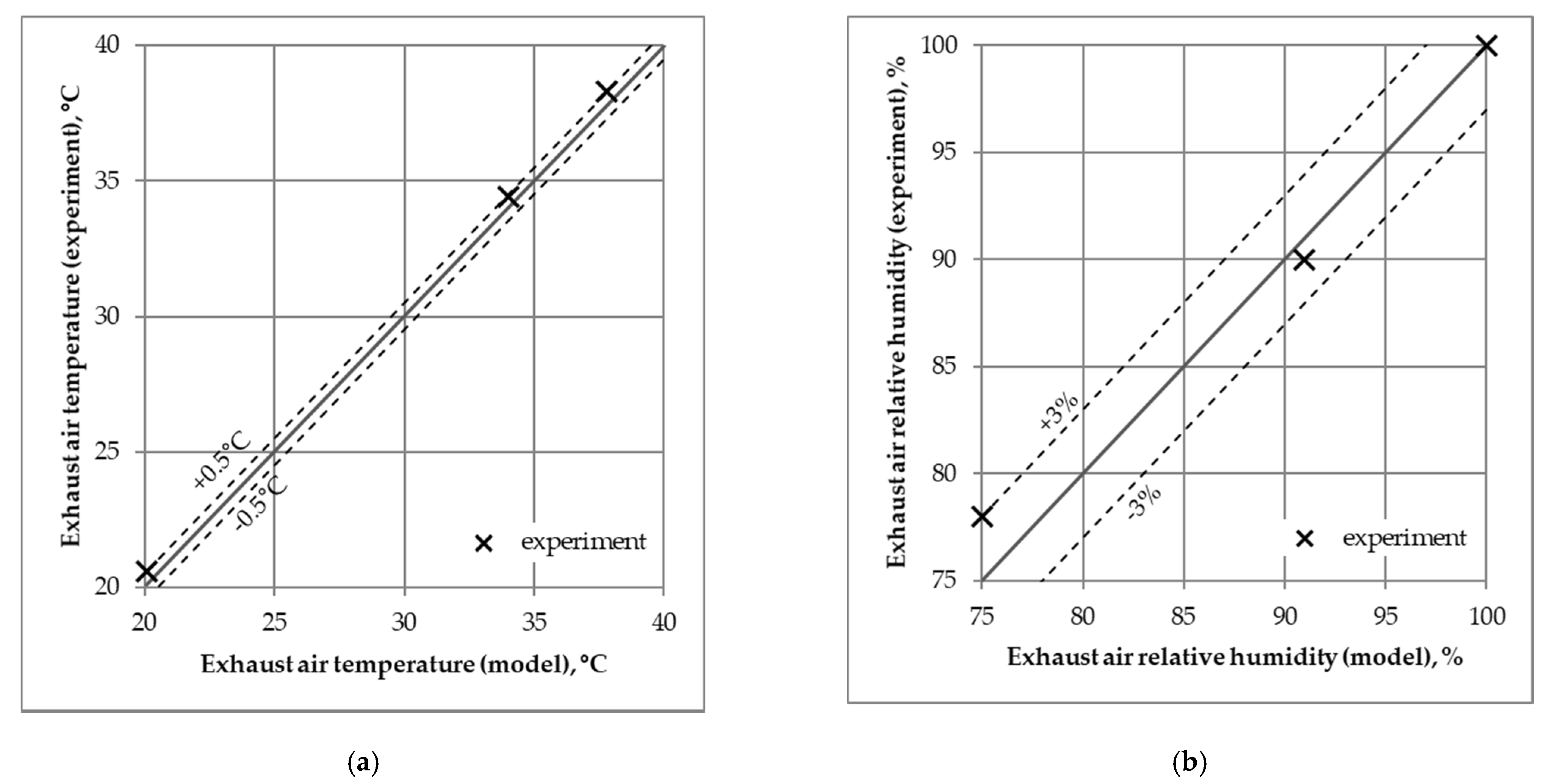
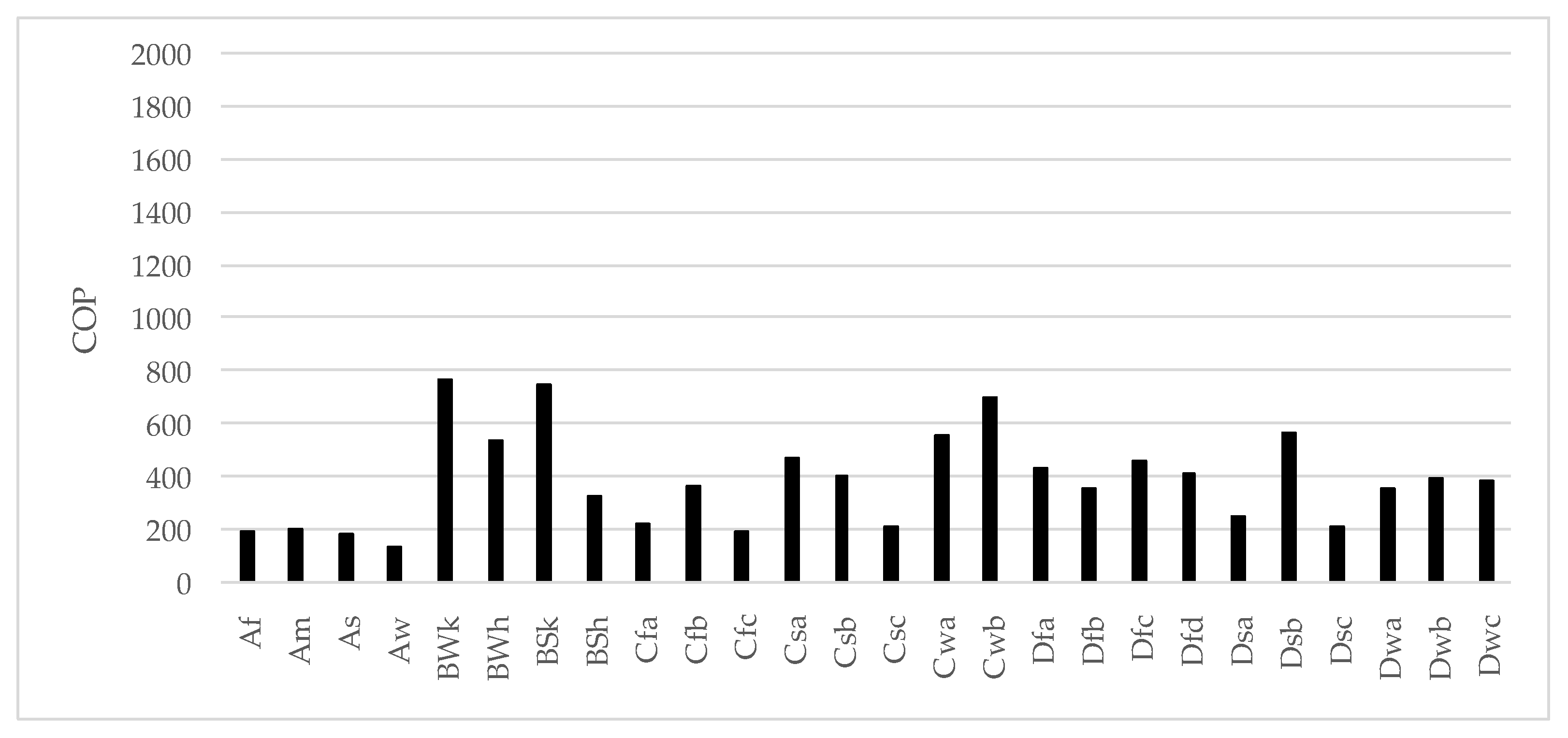
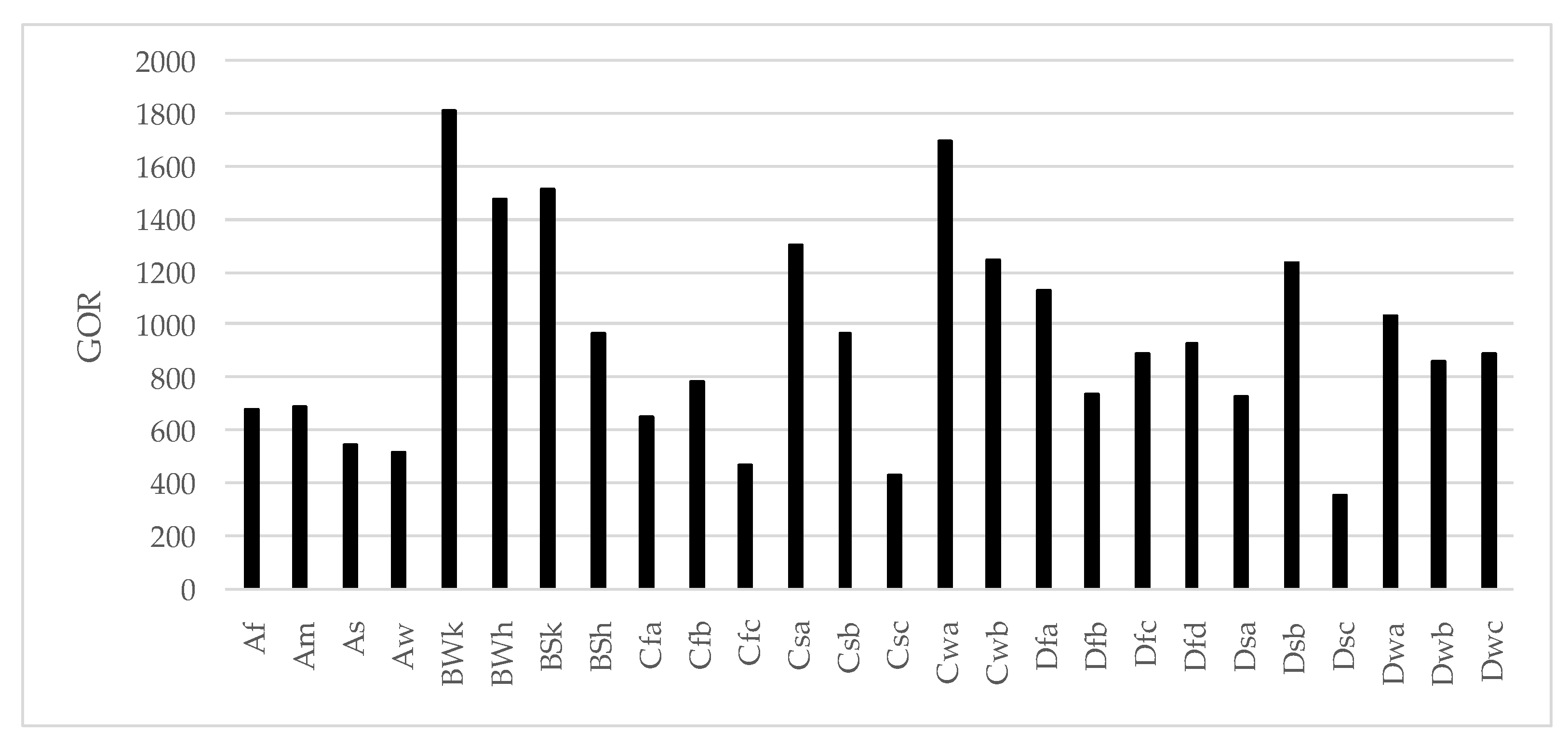
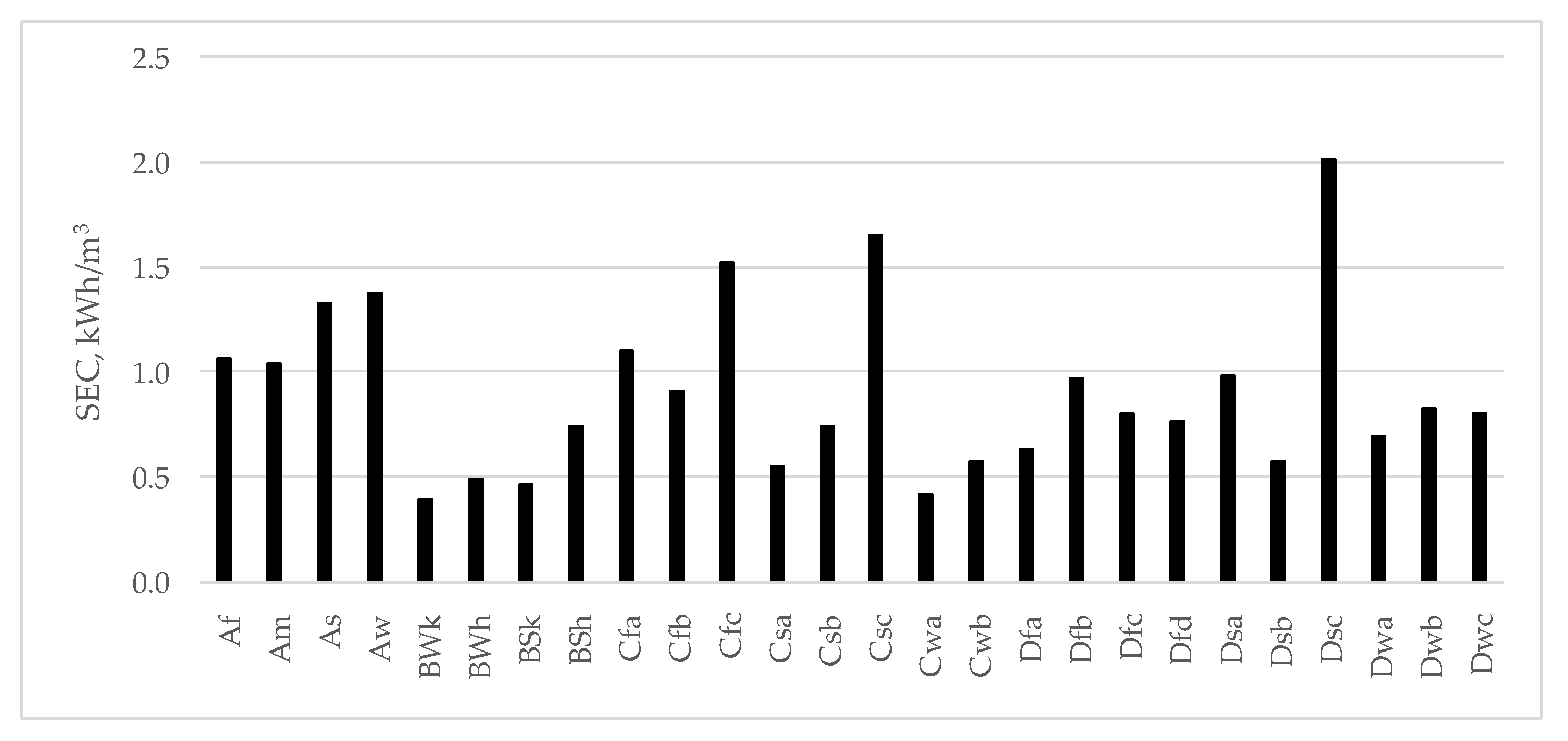

| Parameters | 1st Case | 2nd Case | 3rd Case |
|---|---|---|---|
| Volume flow rate of ambient air, m3/h | 340 | 340 | 455 |
| Inlet temperature of ambient air, °C | 20.6 | 18.3 | 26.1 |
| Inlet relative humidity of ambient air, % | 23 | 33 | 69 |
| Parameter | 1st Stage | 2nd Stage |
|---|---|---|
| Length, m | 0.50 | 0.50 |
| Width, m | 2.30 | 1.00 |
| Height, m | 2.30 | 1.25 |
| Channel height, m | 0.004 | 0.004 |
| Wall thickness, m | 0.0003 | 0.0003 |
| Heat exchange surface, m2 | 581 | 145 |
| Number of primary channels | 253 | 145 |
| Symbol | Climatic Zone | Latitude | Longitude | t °C | x g/kg | EUF |
|---|---|---|---|---|---|---|
| Af | Tropical rainforest | 1.37 N | 103.92 E | 33.2 | 18.9 | 0.90 |
| Am | Tropical monsoon | 25.82 N | 80.3 W | 32.7 | 17.3 | 0.94 |
| As | Tropical savanna, dry | 21.98 N | 159.34 W | 29.1 | 16.0 | 0.87 |
| Aw | Tropical savanna, wet | 10.60 N | 66.98 W | 33.1 | 21.3 | 0.89 |
| BWk | Hot semi-arid | 33.42 N | 36.52 E | 38.0 | 4.9 | 0.95 |
| BWh | Cold semi-arid | 30.10 N | 31.18 E | 36.9 | 9.8 | 0.89 |
| BSk | Hot deserts | 39.75 N | 104.87 W | 32.9 | 3.9 | 0.95 |
| BSh | Cold desert | 34.57 N | 32.97 E | 33.3 | 13.5 | 0.89 |
| Cfa | Humid subtropical | 34.57 S | 58.42 W | 29.8 | 14.7 | 0.93 |
| Cfb | Temperate oceanic | 51.52 N | 0.1 W | 26.2 | 9.0 | 0.88 |
| Cfc | Subpolar oceanic | 37.00 S | 174.80 E | 24.3 | 11.9 | 0.89 |
| Csa | Hot-summer Mediterranean | 38.52 N | 27.02 E | 35.2 | 10.2 | 0.95 |
| Csb | Warm-summer Mediterranean | 33.97 S | 18.60 E | 29.2 | 9.4 | 0.94 |
| Csc | Cool-summer Mediterranean | 29.92 S | 71.2 W | 21.3 | 9.8 | 0.90 |
| Cwa | M-i 1, humid subtropical | 28.58 N | 77.20 E | 40.7 | 10.1 | 0.91 |
| Cwb | Subtropical highland | 19.43 N | 99.13 W | 27.9 | 3.9 | 0.90 |
| Dfa | Hot-summer humid continental | 19.43 N | 99.13 W | 32.5 | 10.4 | 0.89 |
| Dfb | Warm-summer humid continental | 19.43 N | 99.13 W | 24.9 | 8.2 | 0.89 |
| Dfc | Subarctic | 64.82 N | 147.86 W | 25.7 | 6.7 | 0.90 |
| Dfd | Extremely cold subarctic | 62.02 N | 129.72 E | 28.2 | 9.0 | 0.90 |
| Dsa | Hot, dry-summer continental | 42.85 N | 74.53 E | 33.7 | 7.5 | 0.75 |
| Dsb | Warm, dry-summer continental | 39.75 N | 37.02 E | 30.5 | 7.1 | 0.89 |
| Dsc | Dry-summer subarctic | 59.65 N | 151.48 W | 17.3 | 7.6 | 0.88 |
| Dwa | M-i 1, warm-summer humid continental | 39.93 N | 116.28 E | 33.2 | 12.7 | 0.95 |
| Dwb | M-i 1, subarctic | 52.27 N | 104.32 E | 26.8 | 8.7 | 0.89 |
| Dwc | M-i 1, extremely cold subarctic | 53.47 N | 122.40 E | 28.5 | 9.5 | 0.87 |
| Water Recovery Method | DPC-WR | RO | MSF | MED |
|---|---|---|---|---|
| Electric energy consumption, kWh/m3 | 0.5–2.0 | 4–6 | 2.5–5 | 2–2.5 |
| Heat source required | no | no | yes | yes |
| Thermal energy consumption, kWh/m3 | none | none | 15.8–23.5 | 12.2–19.1 |
| Combined Cooling and Water Recovery Method | DPC-WR | HDH-VAR [12] | HDH-AD [13] | HDH-VC [15] | IEC-HDH [19] |
|---|---|---|---|---|---|
| Energy Utilization Factor (EUF) | 0.76–0.96 | 0.58 | N/A | 8.27 | N/A |
| Coefficient of Performance (COP) | 138–768 | N/A | >0.45 | 2.16 | 2.1–2.5 |
| Gained Output Ratio (GOR) | 354–1814 | N/A | >7.6 | 6.11 | 1.6–2.5 |
Publisher’s Note: MDPI stays neutral with regard to jurisdictional claims in published maps and institutional affiliations. |
© 2021 by the authors. Licensee MDPI, Basel, Switzerland. This article is an open access article distributed under the terms and conditions of the Creative Commons Attribution (CC BY) license (http://creativecommons.org/licenses/by/4.0/).
Share and Cite
Cichoń, A.; Worek, W. Analytical Investigation of a Novel System for Combined Dew Point Cooling and Water Recovery. Appl. Sci. 2021, 11, 1481. https://doi.org/10.3390/app11041481
Cichoń A, Worek W. Analytical Investigation of a Novel System for Combined Dew Point Cooling and Water Recovery. Applied Sciences. 2021; 11(4):1481. https://doi.org/10.3390/app11041481
Chicago/Turabian StyleCichoń, Aleksandra, and William Worek. 2021. "Analytical Investigation of a Novel System for Combined Dew Point Cooling and Water Recovery" Applied Sciences 11, no. 4: 1481. https://doi.org/10.3390/app11041481
APA StyleCichoń, A., & Worek, W. (2021). Analytical Investigation of a Novel System for Combined Dew Point Cooling and Water Recovery. Applied Sciences, 11(4), 1481. https://doi.org/10.3390/app11041481





